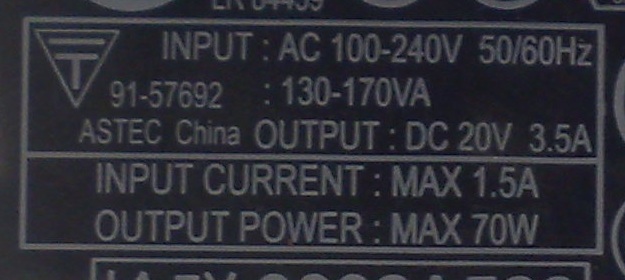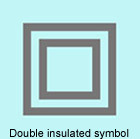Adaptor safety concerns
Not official safety advice just guidance
Equipment from outside the UK can often come with a non-standard mains lead. It may also run at a different voltage!
Mains power in the UK
The mains voltage in the UK is nominally 230V RMS at 50Hz. The AC voltage is between the two shorter pins on a BS 1363 plug. Of these pins one is considered "live" and the other is "neutral". This is because the voltage between neutral and earth is much lower than the voltage between live and earth. All appliances must have at least one fuse on their live input.
Equipment Markings
Many devices are capable of handling a range of voltages & frequencies. See this from a Dell laptop power supply:
 which shows that the adaptor will be able to cope with a wide range of voltages at either 50Hz or 60Hz.
which shows that the adaptor will be able to cope with a wide range of voltages at either 50Hz or 60Hz.
If a device is double insulated it means that none of the exterior of the device can be connected to either live or neutral. This kind of device does not need to be earthed. The logo indicating that a device is double insulated is:

Of course, these is no harm in using an earthed mains lead for this equipment.
Replacing the mains lead
If the equipment has a replacable cable the best practise is to replace it with a suitable UK standard one. For IEC C13/C14 cables (incorrectly known as "kettle leads") there is a stock in the computer officer's office and he'd be glad to get rid of some of them.
Wikipedia info on C13/C14 cables
For other types of connector please see Videk or CPC.
Adapting
Europe
There are a variety of different standards used across the EEA, fortunately the voltage is 230V throughout. However, many countries do not differentiate between live & neutral. When using an adaptor to plug European devices into a UK socket the adaptor must have a fuse, and if the device is not double insulated, it must be earthed. An important consideration is that German-style, French-style and Italian-style sockets are earthed in different ways. German sockets have their earth connections on the top & bottom of the plug, whereas the French sockets have a pin sticking out of the socket (a hermaphrodite socket). Finally, older Italian equipment may have 3 pins all in-line. The centre one is earth. Your adaptor must use the same earthing mechanism as the plug you're trying to use.
North America
North American equipment will generally be designed to run at 110V at 60Hz, which is less than half the voltage used in the UK and a slightly different frequency. If the equipment is unable to cope with the higher voltage it may be possible to connect it through a specially designed transformer.
